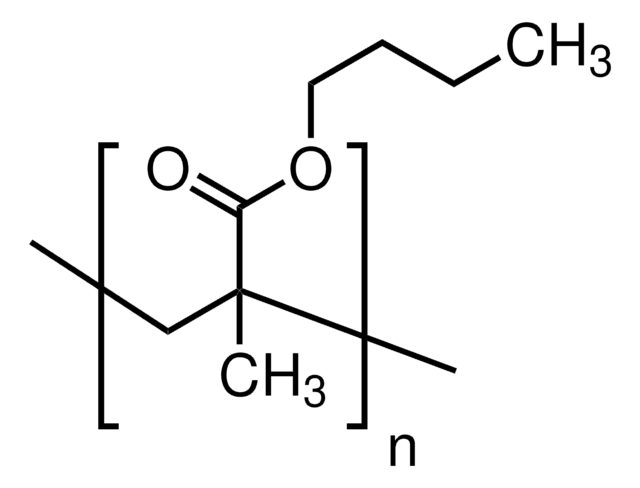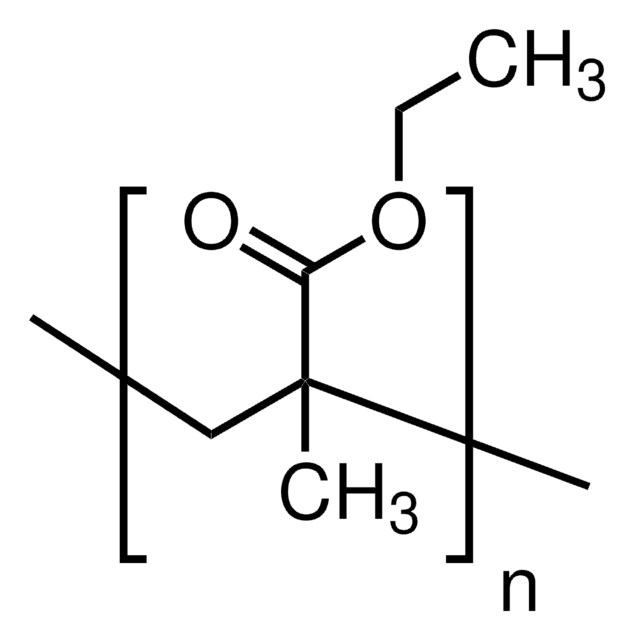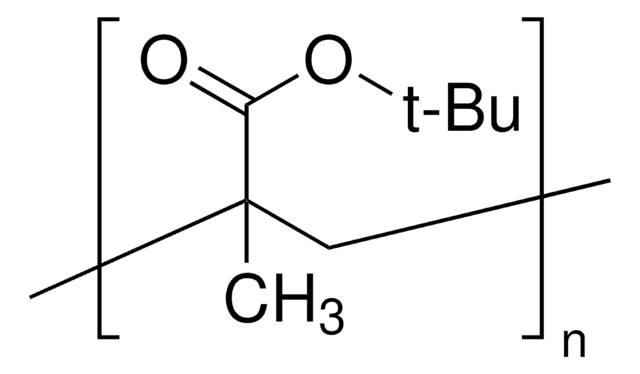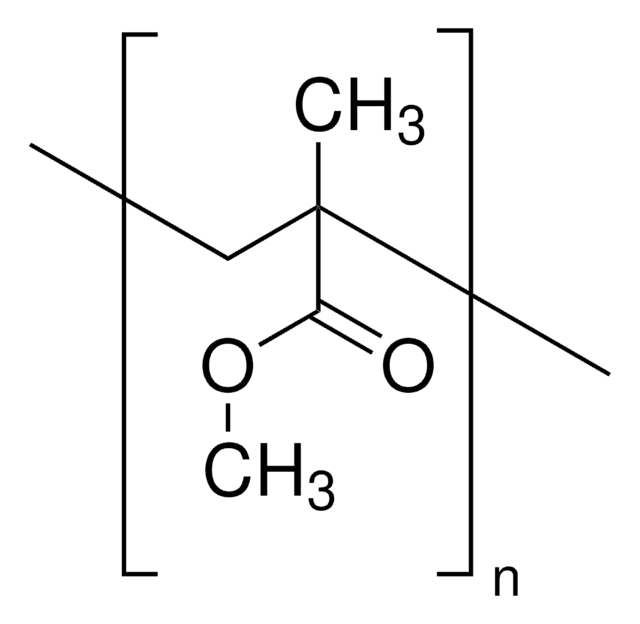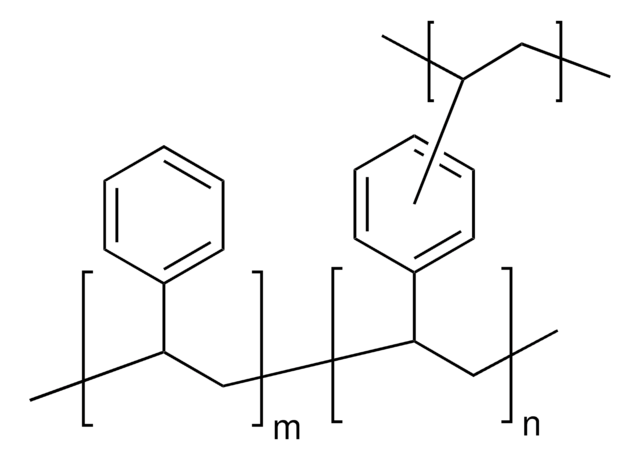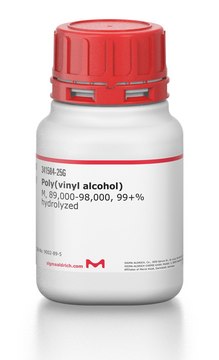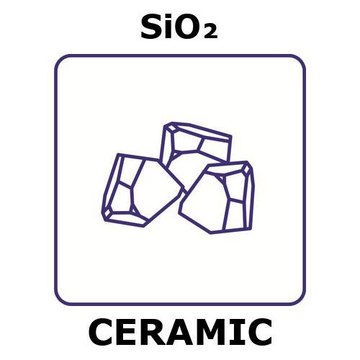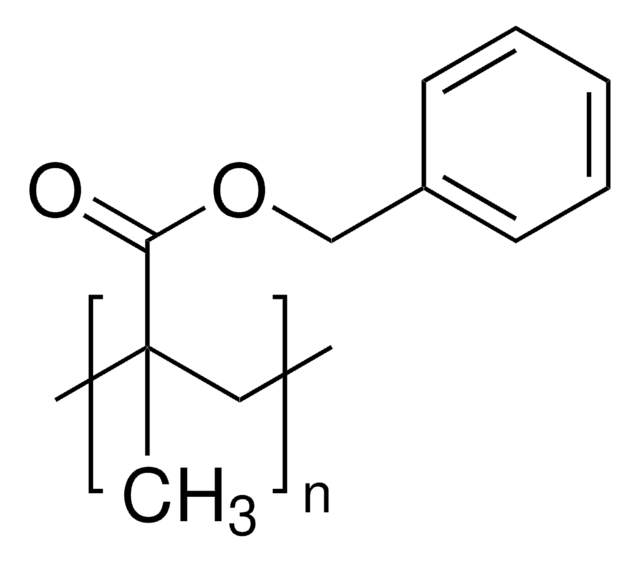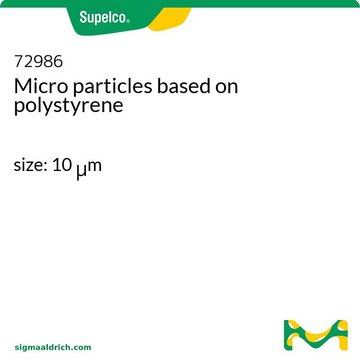推荐产品
描述
Brookfield Viscosity in 40% toluene: 500-800 cPs
Glass transition temperature onset: 20 °C
Maximum % Moisture: 0.30%
表单
solid (bead)
分子量
Mw 211,000
折射率
n/D 1.483
密度
1.07 g/mL at 25 °C (lit.)
SMILES字符串
O(CCCC)C(=O)C(=C)C
InChI
1S/C8H14O2/c1-4-5-6-10-8(9)7(2)3/h2,4-6H2,1,3H3
InChI key
SOGAXMICEFXMKE-UHFFFAOYSA-N
一般描述
其他优点:
传统的高分子量聚(甲基丙烯酸丁酯)很容易形成熔块,因此使用前需要机械力(如锤击)将其分解发小颗粒。该产品采用防堵技术,呈珠状,使用方便、流动自如。
传统的高分子量聚(甲基丙烯酸丁酯)很容易形成熔块,因此使用前需要机械力(如锤击)将其分解发小颗粒。该产品采用防堵技术,呈珠状,使用方便、流动自如。
应用
聚(甲基丙烯酸丁酯)可应用于各种领域。
它可用于研究嵌在聚甲基丙烯酸丁酯 (PBMA) 聚合物膜中的 EuTFC 的光致发光。
它还可用作涂料、表面改性、固态电池、孔版印墨、塑料和铝用粘合剂、硬甲基丙烯酸丁酯树脂的增塑剂以及改善着色漆中氯乙烯树脂的户外耐用性。
它可用于研究嵌在聚甲基丙烯酸丁酯 (PBMA) 聚合物膜中的 EuTFC 的光致发光。
它还可用作涂料、表面改性、固态电池、孔版印墨、塑料和铝用粘合剂、硬甲基丙烯酸丁酯树脂的增塑剂以及改善着色漆中氯乙烯树脂的户外耐用性。
制备说明
如何制备溶液:
这种聚合物在室温下溶解,但需要不断搅拌,以防止聚合物溶胀颗粒形成结块并粘着在容器壁上。
重要:聚合物微球直接筛入装有搅拌溶剂的漩涡中,以加速润湿和分散。根据树脂的等级和浓度,建议连续低剪切搅拌1至12小时。
当溶液在储槽中变得澄清后,应将样品铺放在Leneta卡或玻片上。在溶剂蒸发后,卡片或玻片上会形成薄膜,这里不应有任何树脂晶粒。如仍有晶粒,应进一步搅拌储槽,使树脂充分溶解。持续搅拌储槽(取样除外),直到薄膜测试显示没有树脂晶粒。任何混浊或残留物都可能表明某些聚合物仍未溶解。系统中含水也可能导致混浊。
通过加热可缩短溶解时间;大多数常见溶剂都可以加热至49°C(120°F)左右,而无需回流设备。高剪切搅拌也可以缩减溶解时间,但需要小心操作,以避免过热和过多的溶剂损失。
这种聚合物在室温下溶解,但需要不断搅拌,以防止聚合物溶胀颗粒形成结块并粘着在容器壁上。
重要:聚合物微球直接筛入装有搅拌溶剂的漩涡中,以加速润湿和分散。根据树脂的等级和浓度,建议连续低剪切搅拌1至12小时。
当溶液在储槽中变得澄清后,应将样品铺放在Leneta卡或玻片上。在溶剂蒸发后,卡片或玻片上会形成薄膜,这里不应有任何树脂晶粒。如仍有晶粒,应进一步搅拌储槽,使树脂充分溶解。持续搅拌储槽(取样除外),直到薄膜测试显示没有树脂晶粒。任何混浊或残留物都可能表明某些聚合物仍未溶解。系统中含水也可能导致混浊。
通过加热可缩短溶解时间;大多数常见溶剂都可以加热至49°C(120°F)左右,而无需回流设备。高剪切搅拌也可以缩减溶解时间,但需要小心操作,以避免过热和过多的溶剂损失。
警示用语:
Warning
危险声明
危险分类
Skin Sens. 1
储存分类代码
11 - Combustible Solids
WGK
WGK 3
闪点(°F)
Not applicable
闪点(°C)
Not applicable
A poly(butyl methacrylate)/graphene oxide/TiO2 nanocomposite coating with superior corrosion protection for AZ31 alloy in chloride solution
Nazeer A A, et al.
Chemical Engineering Journal, 361, 485-498 (2019)
Kamil Awsiuk et al.
Biomacromolecules, 20(6), 2185-2197 (2019-04-25)
Poly( n-butyl methacrylate) (PBMA) or poly( n-butyl acrylate) (PBA)-grafted brush coatings attached to glass were successfully prepared using atom-transfer radical polymerization "from the surface". The thicknesses and composition of the PBMA and PBA coatings were examined using ellipsometry and time-of-flight
Micro and nanometer scale photopatterning of self-assembled monolayers
Leggett G J
Material Matters, 6(1), 22-29 (2011)
A polymeric coat for nanodroplets.
Anna Carlmark
Nature nanotechnology, 14(7), 640-641 (2019-05-22)
商品
Graphene nanoribbons (GNRs) are quasi-one-dimensional narrow strips of graphene comprised of sp2-hybridized carbon atoms arranged into hexagonal honeycomb lattice configurations.
我们的科学家团队拥有各种研究领域经验,包括生命科学、材料科学、化学合成、色谱、分析及许多其他领域.
联系技术服务部门